The Myth of the Sailor Stagehand
by R.W. (Rick) Boychuk
Chapter 3:
The Myth of the Sailor Stagehand
from the upcoming book The History of Counterweight Rigging
by R.W. (Rick) Boychuk. Expected release in March 2015.
We have believed that stage rigging has a profound and long nautical tradition.
“Stage rigging techniques draw largely from ship rigging. That origin is most obvious with hemp rigging, which uses closely related technology and terminology. To this day, the stage is referred to as a deck in the manner of a ship's deck. Other expressions and technology that overlap the nautical and theatrical rigging worlds include: batten, belay, block, bo'sun, cleat, clew, crew, hitch, lanyard, pinrail, purchase, trapeze, and trim.” Wikipedia, November 2014
I do not wish to single out Wikipedia. The online Encyclopedia Britannica tells us the same story. Books published as recently as this year also repeat the myth.
Yes. The myth. “A traditional story, especially one concerning the early history of a people or explaining a natural or social phenomenon, …” Online Oxford Dictionaries, 2014.
Stage rigging does not find its origin in ship’s rigging, as the above-cited extract would cause one to infer. Any nautical tradition that we might have is recent; if we can call 160 years ago recent. But given that modern theatre scenic practice is 400 years old, 160 years ago is recent. Modern theatre starts with Teatro Farnese in 1618. Farnese was the first theatre with a proscenium arch.
When we point to a small number of things and make a conclusion, we use inductive reasoning; the opposite of Holmes’ deductive reasoning.
To look back to Wikipedia, the use of the word ‘deck’ is suggested to be evidence of a nautical heritage. But let's look at the origins of the word itself.
“late Middle English: from Middle Dutch dec ‘covering, roof, cloak,’ dekken ‘to cover.’ Originally denoting canvas used to make a covering (especially on a ship), the term came to mean the covering itself, later denoting a solid surface serving as roof and floor.” Online Oxford Dictionaries, 2014.
So the roots of the word ‘deck’ mean ‘to cover’ something. As in ‘deck the halls’. And ‘all decked out’.
If we visit the catalogue of JR Clancy for 1899-1900 we find the product category of ‘stage carpeting’.
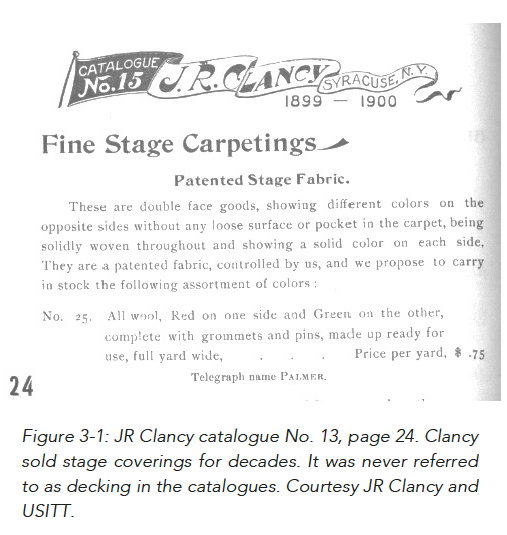
For the next 30 years Clancy will offer various products to cover the stage floor – to deck them.
I offer the word ‘deck’ as a stage covering, not as proof; it isn’t proof. But perhaps it is the thin edge of the wedge of examination.
If the pin rail is proof of nautical roots of rigging we should find pin rails in the oldest of theatres that featured rigging. We don’t. We find cleat rails. We should find pin rails in not so old theatres. We do not. We find cleat rails. We should find pin rails in theatres all over Europe – the birthplace of the modern theatre. We do not. We find cleat rails. 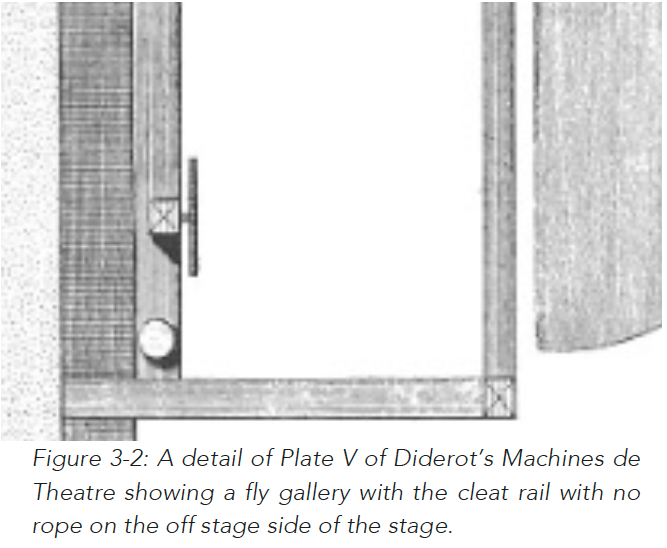
The Hall Stage catalogue of 1966 does not offer belaying pins and pin rails. It offers cleats of various sizes. In fact, to this very day, cleat rails continue to be installed in the UK. Not pin rails.
But we might argue that cleats are nautical, too. It is a point with merit. But cleat rails are not nautical. Pin rails are nautical. For nautical use, cleats were used horizontally and singly, not vertically, and not in multiples in the form of cleat rails.
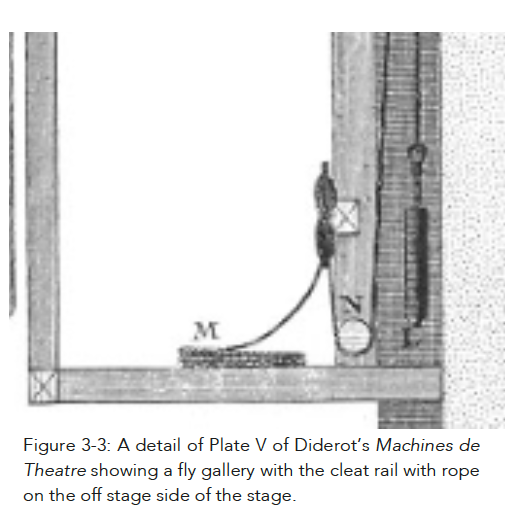
John H. Green wrote his thesis in 1954 for the University of Denver. It was titled: The History of Stage Rigging in the United States: 1766 to 1893.
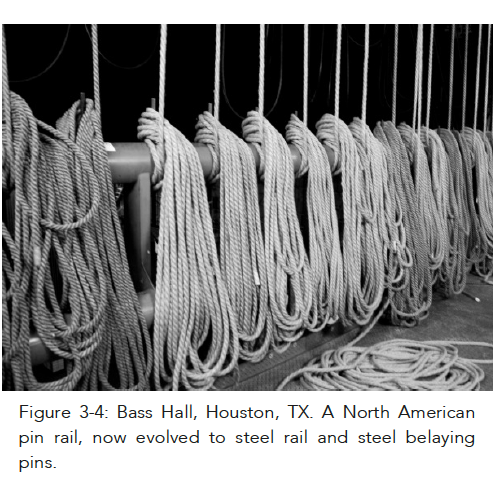
Green’s work is inspiring. He has a reference to a cleat rail that appears in a letter from Earnest Woodrow, writing in 1893, in which he is describing the ‘flies’ of the second Park Theatre built in 1821 in New York.
“The fly rail is generally a deep lattice or trussed girder running from the back to the front, it need be very strong for upon it are fixed all the “cleats” to which the ropes holding the scenery are secured.”
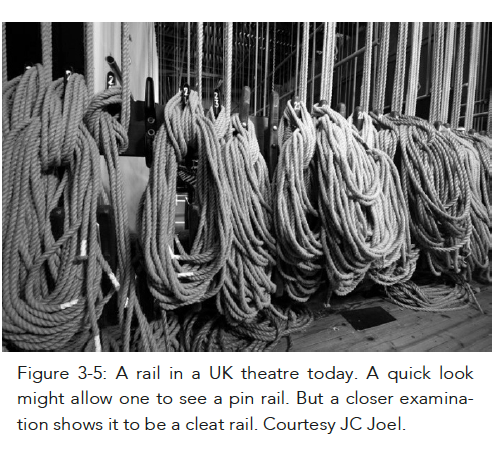
Woodrow was an architect with a profound understanding of theatres and their machinery, whom Green, writing in 1954, goes on to correct by saying
“This, of course, is the twentieth century pin rail…”
No. Woodrow had it right. When Woodrow wrote cleat, he meant cleat. And he was very specific in the way he described ‘upon it are fixed all the cleats’. Were it to have been a pin rail the phrase would be more like ‘into it are inserted all…’ etc. Green, 60 years later, seems to have had no understanding of the existence of a cleat rail. But, to be fair to Green, three weeks before writing this, neither did I. So filtered is our perception of history that we sometimes miss the obvious. Since my identification of the cleat rail, I see it in theatres constantly – in Europe, but not in the United States.
By 1886, we find a belaying pin available in the first Clancy catalogue. The Sosman & Landis catalogue of 1889 offers a belaying pin. Neither offers a lashing cleat for stage rigging1. The Crump Theatre in Columbus, Indiana is delivered with a pin rail in 1889. Sometime between 1821 – when the cleat rail was installed in the Park - and 1886, the pin rail made the move to land and dis-placed the cleat rail. To split the difference be-tween the two years, the pin rail moves to the stage in 1850, making it 164 years old. It would be of great use to determine when the pin rail was actually adopted by the stage.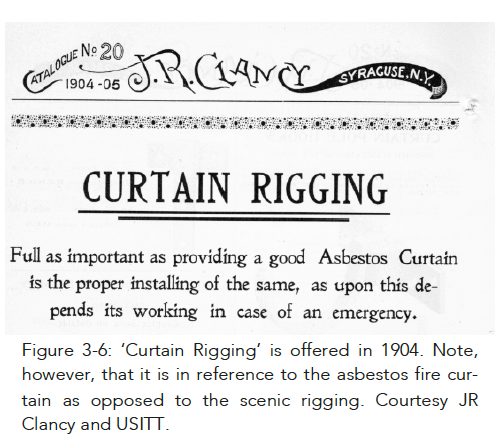
No writing that encountered by this author from the 19th century, whether European or North American, refers to rigging. It all refers to machinery. The machinery used to fly soft goods was called ‘upper machinery’. The machinery used below deck was called ‘under machinery’. The person charged with designing, making and in-stalling the machinery was the ‘stage machinist’. There appears to be no rigging and no riggers before the 20tth century.
The use of the word rigging is recent. A date for the beginning of the use of the word has not been determined. It doesn’t appear in a Clancy catalogue until 1904 on page 14 where it offers “Curtain Rigging”. 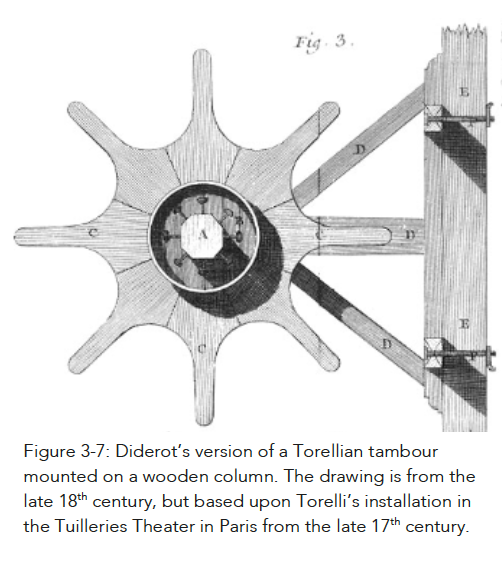
It was pointed out to me that the tambour of the age of the wooden machinery bears a striking resemblance to a ship’s wheel – the implication being that the former was descended from the latter. Yet, “the ship’s wheel did not appear until the 18th century” 2. Some argue that the ship’s wheel was introduced in 1703-4. Others offer 1711 as the year. Torelli had introduced the tambour as early as 1641. Perhaps there was techno-logical movement in the opposite direction to what we have supposed; perhaps theatre provided an important technology to the nautical world.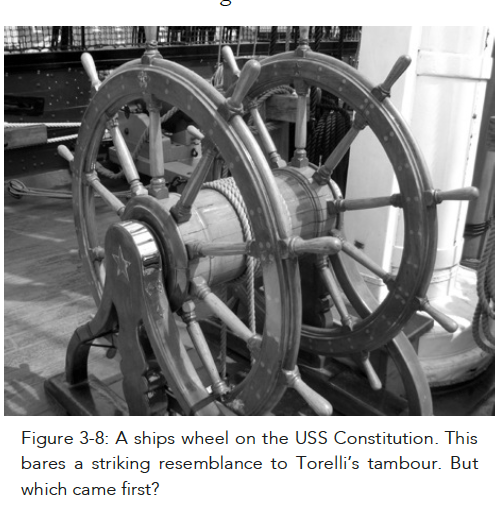
Susan Stockbridge submitted her master’s thesis at Stanford University in 1961. The title was The Development of Methods for Flying Scenery on the English Stage: 1800 – 1960. On page 50 there is a footnoted quote. The quote is from The English Theatre (London: Thomas Nelson and Sons Ltd., 1936), page146 by Allardyce Nicoll. Nicoll taught at Yale Drama School from 1933 until just before the US entered the war. He was head of the School for part of the time.
The English stage had:
‘blocks, wheels, and ropes crossing each other in every direction … (that) it had very much the appearance of a ship’s deck’.
It is this author’s interpretation that Nicoll is using metaphor to establish an image in the mind of the reader. It is not the impression that, with these words, he is being literal.
But in the very next paragraph Stockbridge goes on to write:
“The reference to the appearance of a ship’s deck is particularly applicable to the nineteenth century fly gallery since the rope system of flying scenery involved the tying off of the ropes to belaying pins on the rail, an almost exact counterpart of the rail of a frigate. The wooden pins slipped into holes in the rail and the ropes were wound around them in such a way that they could be easily released by pulling the pin from the hole.”
Stockbridge stops short of saying that the technology of the stage is based upon the nautical tradition. But she comes close enough to allow the reader to infer it. Stockbridge does not foot-note the second paragraph. This is her, instructing the reader. Is she instructing based upon that with which she is familiar as common practice on stage … in 1961?
Furthermore, Stockbridge makes the same mistake as Green. Nicoll is writing about the English stage. She transplants the pin rail - which is ubiquitous in the United States starting in the mid-nineteenth century - to England – where it is all but unused. Nicoll does not mention a rail at all, let alone say that it is a pin rail.
And, to add to the confusion, Stockbridge, later in her paper writes of both pin rails and cleat rails, but does not distinguish between the two. She mentions them in passing on to other points.
Is Nicoll ground zero of the nautical myth, despite that he did not at all say that? And Stock-bridge pushed it along by implication? And then we picked it up as fact?
And, if further discussion is needed; ‘Au cour’ and ‘au jardin’ are terms used by technicians in the Paris Opera House to distinguish between the sides of the stage. “Au cour’ was the side of the stage with court palace on that side of the theatre building. ‘Au jardin’ was the side with a garden on that side of the building.
The English of the 19th century had P. and O.P. – prompt and opposite prompt for right and left of the stage. And in North America we have stage right and stage left.
If we had a profound nautical tradition, why didn’t we use ‘port’ and ‘starboard’ in our nomenclature?
Furthermore, most of the sailors - from the beginnings of seafaring until after the Napoleonic wars - perished at sea. The twin scourges of scurvy and the rigor of the nautical life took an extremely high toll. William Manchester, in his book A World Lit Only By Fire, reminds us that only 18 of 237 original crew survived Magellan’s circumnavigation of the globe. That is a 7.6% survival rate. And in To Rule The Waves: How the British Navy Shaped the Modern World Arthur L. Herman tells us that Nelson’s numbers, three hundred years later, were equally dismal. The brave sailors that defeated Napolean’s navy at Trafalgar, were left to perish from injuries, disease and hunger on the wharfs of Southampton. A sorry story not much repeated.
The point is that sailors did not retire to a happy life aloft in the theatre. Statistically, they did not retire at all. Statistically, they died at sea. Only after the British Navy matured, in the mid 19th century, did any expectation of retirement develop.
And, of course, neither Magellan nor Nelson survived their nautical careers.
One can well imagine that sailors left the ships at the beginning of the steam era and that some – perhaps many – found a new life aloft in the theatre. But it seems that they were latecomers. And, although they brought with them some improved technologies and some jargon, they did not lay the foundations of stage rigging practice.
A myth is not a lie. A myth is a necessary untruth. Myths grow up where we need to fill in a part of history for which we have no facts. The myth of the sailor stagehand has been useful. But perhaps it is time to put it into its proper place in history.
This is important, for without this under-standing it is difficult to see how counterweight rigging developed. The heavy use of hemp rigging and adoption of the pin rail was an American development. The counterweight rigging system was an Austrian development. They are not related except by application. But, even if we agree that they are related, they are – at best - second cousins.
1 Both catalogues offer lashing cleats for joining adjacent scenery flats. Those are a different kind of cleat.
2 The Age of Reconnaissance, J H Parry, Chapter IV: Pilotage and Navigation, Orion Publishing Group, London, UK, 2010.
Copyright © R.W. (Rick) Boychuk, 2014.
